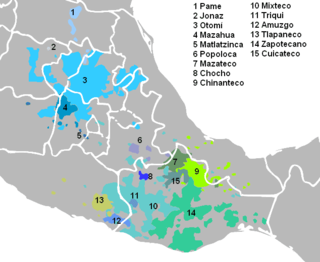| Amuzgo | |
|---|---|
| Amuzgoan | |
| Native to | Mexico |
| Region | Guerrero, Oaxaca |
| Ethnicity | Amuzgo people |
Native speakers | 60,000 (2020 census)[1] |
Oto-Manguean
| |
| Language codes | |
| ISO 639-3 | Variously:amu – Northern (Guerrero) Amuzgoazm – Ipalapa Amuzgoazg – San Pedro Amuzgos (Oaxaca) Amuzgo |
| Glottolog | amuz1254 |
 The Amuzgo language, number 12 (darker blue), southwest. | |
Amuzgo is an Oto-Manguean language spoken in the Costa Chica region of the Mexican states of Guerrero and Oaxaca by about 60,000 speakers.[2] Like other Oto-Manguean languages, Amuzgo is a tonal language. From syntactical point of view Amuzgo can be considered as an active language. The name Amuzgo is claimed to be a Nahuatl exonym but its meaning is shrouded in controversy; multiple proposals have been made, including [amoʃ-ko] 'moss-in'.[3]
A significant percentage of the Amuzgo speakers are monolingual; the remainder also speak Spanish.
Four varieties of Amuzgo are officially recognized by the governmental agency, the Instituto Nacional de Lenguas Indígenas (INALI).[4] They are:
- (i) Northern Amuzgo (amuzgo del norte, commonly known as Guerrero or (from its major town) Xochistlahuaca Amuzgo);
- (ii) Southern Amuzgo (amuzgo del sur, heretofore classified as a subdialect of Northern Amuzgo);
- (iii) Upper Eastern Amuzgo (amuzgo alto del este, commonly known as Oaxaca Amuzgo or San Pedro Amuzgos Amuzgo);
- (iv) Lower Eastern Amuzgo (amuzgo bajo del este, commonly known as Ipalapa Amuzgo).
These varieties are very similar, but there is a significant difference between western varieties (Northern and Southern) and eastern varieties (Upper Eastern and Lower Eastern), as revealed by recorded text testing done in the 1970s.[5]
Three dictionaries have been published for Upper Eastern Amuzgo in recent years. For Northern Amuzgo, no dictionary has yet been published, yet it too is very actively written. Lower Eastern Amuzgo and Southern Amuzgo (spoken in Huixtepec (Ometepec), for example) are still not well documented, but work is underway.
While the Mixtecan subdivision may indeed be the closest to Amuzgo within Oto-Manguean,[6] earlier claims that Amuzgo is part of it have been contested.[7]
- ^ Lenguas indígenas y hablantes de 3 años y más, 2020 INEGI. Censo de Población y Vivienda 2020.
- ^ 2005 census; http://www.inegi.org.mx/est/contenidos/espanol/rutinas/ept.asp?t=mlen10&c=3337. Retrieved 21 July 2010.
{{cite web}}: Missing or empty|title=(help) - ^ Campbell (1997:402)
- ^ Catálogo de las lenguas indígenas nacionales: Variantes lingüísticas de México con sus autodenominaciones y referencias geoestadísticas. "Variantes lingüísticas de la agrupación zapoteco". Archived from the original on 16 November 2007. Retrieved 17 July 2013..
- ^ Egland, Bartholomew & Cruz Ramos, 1983:8.
- ^ Campbell (1997:158)
- ^ Longacre (1961, 1966a, 1966b); Longacre & Millon (1961)